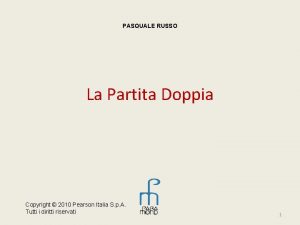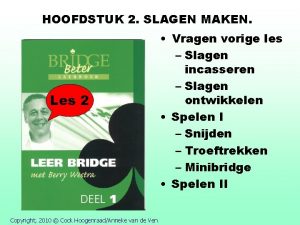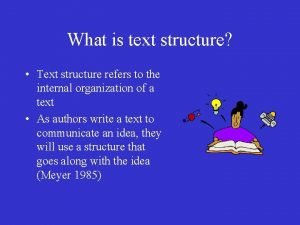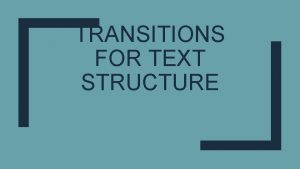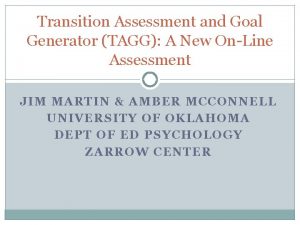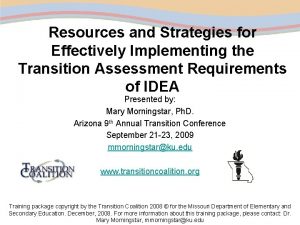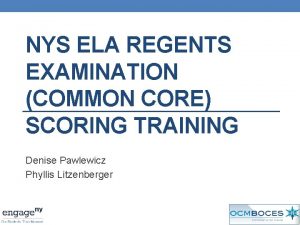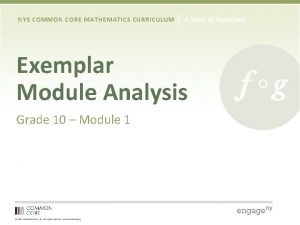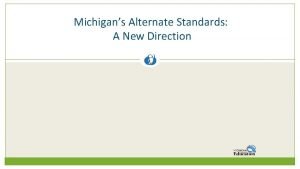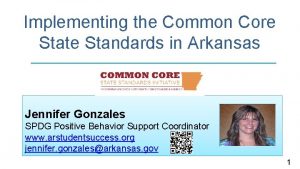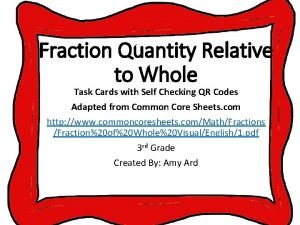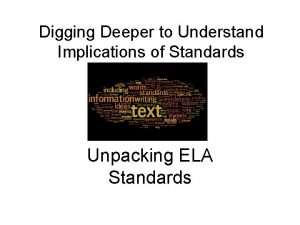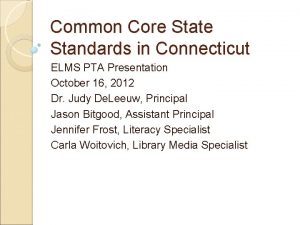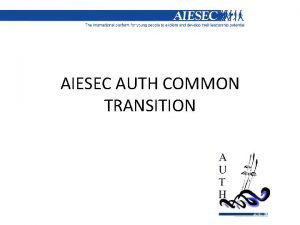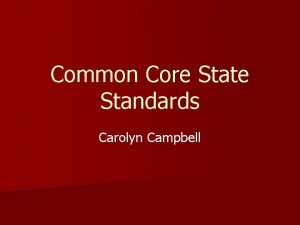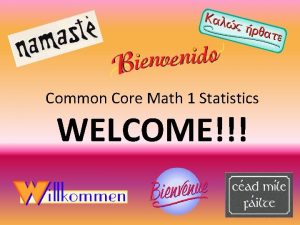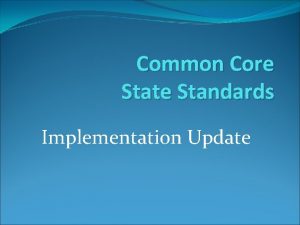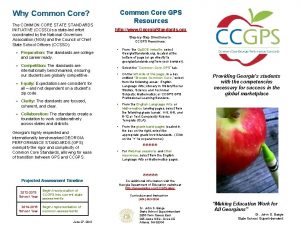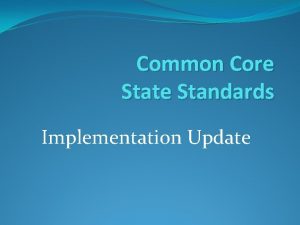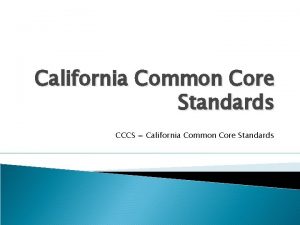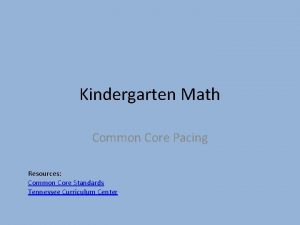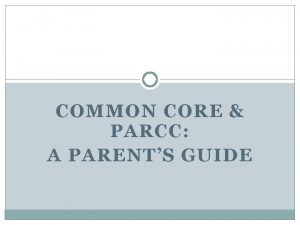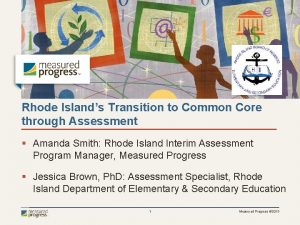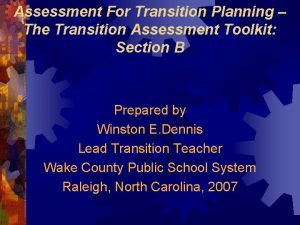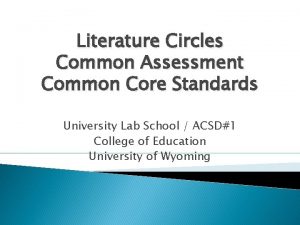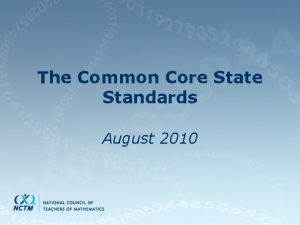Transition to PA Common Core Assessment Copyright 2010































- Slides: 31

Transition to PA Common Core Assessment Copyright © 2010 Commonwealth of Pennsylvania

Rigor PA Common Core Dive Deeper Math Practices Assessment Local Curriculum Toolbox

Please Do the Following: • Connect to the Internet • Navigate to: http: //www. pdesas. org – If a registered user, sign-in – If not a registered user, join now • Place your name and school district/organization on your name tent Your School District/Organization Your Name Copyright © 2010 Commonwealth of Pennsylvania 3

Essential Questions • How are formative assessments and summative assessments similar and different? • What processes and strategies support checks for understanding and assessment? • What are the characteristics of assessment questions that engage students and have real world connections? Copyright © 2010 Commonwealth of Pennsylvania 4

Designing and Using Formative Assessments Activity 1: Check for Understanding According to Understanding by Design: Which of the following are techniques to check for understanding? 1) Index card summaries / questions 6) Visual representation 2) Hand signals 7) Oral questioning 3) One-minute essay 8) Follow-up probes 4) Question box or board 9) Misconception check 5) Analogy prompt 10) Ticket out the door Source: Understanding by Design, pp. 248 -249 Copyright © 2010 Commonwealth of Pennsylvania 5

Designing and Using Formative Assessments Misconceptions About Formative Assessment • Students’ correct answers indicate understanding. • Questions means students understand. • Large groups of learners make formative assessment impossible. Source: Adopted from Understanding by Design, pp. 247 Copyright © 2010 Commonwealth of Pennsylvania 7

Designing and Using Formative Assessments Clarification: Using Hand Signals as a Formative Assessment Strategy • If we move on when we see a lot of thumbs up, then the Formative Assessment is FAILING to inform instruction. Copyright © 2010 Commonwealth of Pennsylvania 8

Designing and Using Formative Assessments Clarification: Using Hand Signals as a Formative Assessment Strategy • If we go back and repeat the same instruction louder and slower when we see some nonaffirmative responses, we are FAILING to differentiate. Copyright © 2010 Commonwealth of Pennsylvania 9

Designing and Using Formative Assessments Differentiation means… “…consistently using a variety of instructional approaches to modify content, process, and/or products in response to learning readiness and interest of academically diverse students. ” - Carol Ann Tomlinson Source: Ellis, E. , Gable, R. A. , Gregg, M. , & Rock, M. L. (2008). REACH: A framework for differentiating classroom instruction. Preventing School Failure, p 32. Copyright © 2010 Commonwealth of Pennsylvania 10

Designing and Using Formative Assessments True or False: Formative assessments are not graded. Copyright © 2010 Commonwealth of Pennsylvania 11

Designing and Using Formative Assessments True or False: An ungraded assessment is a formative assessment. Copyright © 2010 Commonwealth of Pennsylvania 12

Designing and Using Formative Assessments Give an example of a formative assessment. Copyright © 2010 Commonwealth of Pennsylvania 13

Designing and Using Formative Assessments Source: Applying Angle Theorems, MARS Shell Center, University of Nottingham & UC Berkeley http: //map. mathshell. org/materials/lesso ns. php? taskid=214&subpage=concept Copyright © 2010 Commonwealth of Pennsylvania 14

Designing and Using Formative Assessments 1 2 3 4 Source: Applying Angle Theorems, MARS Shell Center, University of Nottingham & UC Berkeley Copyright © 2010 Commonwealth of Pennsylvania 15

Designing and Using Formative Assessments 2 1 3 4 Source: Applying Angle Theorems, MARS Shell Center, University of Nottingham & UC Berkeley Copyright © 2010 Commonwealth of Pennsylvania 16

Designing and Using Formative Assessments A completely different example of a formative assessment… Source: Formative Assessment Probes Math Investigations pp 47 Copyright © 2010 Commonwealth of Pennsylvania 17

Designing and Using Formative Assessments Another example of a formative assessment… Annotated Student Drawings Students make labeled illustrations that • accesses prior knowledge and visual representation of thinking. • encourages sense making and awareness of one’s own ideas • benefits strong visual learners Copyright © 2010 Commonwealth of Pennsylvania 18

Designing and Using Formative Assessments Example of Annotated Student Drawing Source: http: //www. acara. edu. au/curriculum/worksamples/AC_Worksample_Mathematics_1. pdf Copyright © 2010 Commonwealth of Pennsylvania 19

Designing and Using Formative Assessments Five Key Strategies for Effective Formative Assessment 1. Clarifying, sharing, and understanding goals … 2. Engineering effective classroom discussions, questions, activities, and tasks … 3. Providing feedback … 4. Activating students as owners … 5. Activating students as learning resources … Source: www. nctm. org/news/content. aspx? id=11474 Alternate Source: schools. nyc. gov/NR/rdonlyres/40877 F 5 B-D 6 C 0 -4 EB 5 -A 5 A 4 -5644 A 86 CA 523/0/Research_brief_04__Five_Key. Strategies. pdf Copyright © 2010 Commonwealth of Pennsylvania 20

Designing and Using Formative Assessments Example of a Formative Assessment Rubric Copyright © 2010 Commonwealth of Pennsylvania 21

Differences Between Formative and Summative Assessments Directed Paraphrasing: You are a teacher in a local school district. Your partner is the parent of a student in your class. Explain the differences between a formative assessment and a summative assessment to him/her in a parent friendly language. Copyright © 2010 Commonwealth of Pennsylvania 22

Differences Between Formative and Summative Assessments What does SAS say? The Assessment page at SAS. . . www. pdesas. org/module/assessment/About. aspx Copyright © 2010 Commonwealth of Pennsylvania 23

Differences Between Formative and Summative Assessments Formative Occurs before or during instruction Assessment for learning Copyright © 2010 Commonwealth of Pennsylvania Summative Occurs after instruction Assessment of learning 24

Differences Between Formative and Summative Assessments Formative Descriptive feedback Continuous Copyright © 2010 Commonwealth of Pennsylvania Summative Evaluative feedback Periodic 25

Differences Between Formative and Summative Assessments Formative Informal High impact on learning Copyright © 2010 Commonwealth of Pennsylvania Summative Formal Limited positive impact on learning 26

Differences Between Formative and Summative Assessments Is it Formative or Summative? Reference The Council of Chief State School Officers (CCSSO) publications at http: //tinyurl. com/Assessment. Examples Copyright © 2010 Commonwealth of Pennsylvania 27

Differences Between Formative and Summative Assessments Activity 2: Categorize and Transform Using an assessment question that you brought to the workshop… • Determine if it is clearly formative or summative. – Why? Why not? – What changes could be made to the question to place it solidly within the formative or summative domain? • Now modify a question or construct a similar question that is the opposite kind of assessment. – If the question was formative, construct a summative question. – If the question was summative, construct a formative question. Copyright © 2010 Commonwealth of Pennsylvania 28

Designing and Using Summative Assessments To what extent does this reflect student engagement and real world connections? Nancy’s Carpeting Task Nancy is recarpeting her bedroom. Her room is 10 feet wide and 11 feet long. How many square feet of carpet will her parents need to purchase? Copyright © 2010 Commonwealth of Pennsylvania 29

Designing and Using Summative Assessments To what extent does this reflect student engagement & real world connections? Source: Common Core State Standards and Assessments Copyright © 2010 Commonwealth of Pennsylvania 30

Designing and Using Summative Assessments Activity 3: Identify Engagement and Real-World Connections • Underline elements of the assessment that reflect student engagement as indicated through the mathematical practices. • Circle deliberate, real-world connections in the assessment questions. Copyright © 2010 Commonwealth of Pennsylvania 31

Assessment Questions? ? ? Copyright © 2010 Commonwealth of Pennsylvania 32
 2010 pearson education inc
2010 pearson education inc Copyright 2010
Copyright 2010 Variazioni finanziarie attive
Variazioni finanziarie attive Copyright 2010 pearson education inc
Copyright 2010 pearson education inc Copyright 2010 pearson education inc
Copyright 2010 pearson education inc Copyright 2010
Copyright 2010 Nwoz
Nwoz Copyright 2010 pearson education inc
Copyright 2010 pearson education inc Copyright 2010 pearson education inc
Copyright 2010 pearson education inc Copyright 2010 pearson education inc
Copyright 2010 pearson education inc Copyright 2010 pearson education inc
Copyright 2010 pearson education inc Copyright 2010 pearson education inc
Copyright 2010 pearson education inc Copyright 2010 pearson education inc
Copyright 2010 pearson education inc Copyright 2010 pearson education inc
Copyright 2010 pearson education inc Common copyright
Common copyright Common text structures and transition words
Common text structures and transition words Transitions text structure
Transitions text structure The brittle, rocky outer layer of earth
The brittle, rocky outer layer of earth Crust earth definition
Crust earth definition Which layer is the least dense
Which layer is the least dense Purpose of paradox
Purpose of paradox Transition assessment and goal generator
Transition assessment and goal generator Wan transition assessment
Wan transition assessment Unpacking common core standards
Unpacking common core standards Essential elements standards
Essential elements standards English regents rubric
English regents rubric Nys common core mathematics curriculum
Nys common core mathematics curriculum Essential elements michigan
Essential elements michigan Common core standards arkansas
Common core standards arkansas Common core sheets.com
Common core sheets.com Unpacking the standards template
Unpacking the standards template Common core state standards ct
Common core state standards ct


